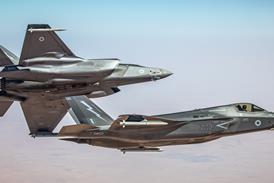The basic Boeing F/A-18C Hornet has long been a Farnborough favourite - the Northrop YF-17 (from which the Hornet was developed) made its Farnborough debut as long ago as 1976. This year marks the Farnborough debut of the new F/A-18E/F Super Hornet. The two aircraft here are drawn from VFA-122 Flying Eagles, the Fleet Readiness Squadron for the Super Hornet, based at NAS Leemore, California. The Hornet has always been a spectacular airshow performer, with an enviable combination of high Alpha capability, carefree handling, and power. But the Hornet is much more than a show-stopping aerobatic performer. "Heritage Hornets", as the early versions are dubbed, remain in service in large numbers with the US Navy, US Marine Corps, Australia, Canada, Kuwait, Malaysia, and Switzerland. Operations The F/A-18 was the world's first true "Swing fighter", able to go from air-to-air to air-to-ground operations at the push of a button. The baseline Hornet is both a superb fighter and also a great attack aircraft, able to operate by day or night, and compatible with a wide range of weapons, including the latest Precision Guided Munitions. During Operation Desert Storm, the F/A-18C became the only US Navy aircraft to shoot down an enemy fighter when two aircraft from VFA-81 shot down a pair of MiG-21s while en route to bomb a target.
The new Super Hornet is a much more capable aircraft, combining the existing F/A-18's agility and performance with improved range, payload, survivability, and potential for growth. Moreover, these characteristics are accompanied by a high degree of commonality - any existing Hornet pilot should feel at home - and affordability. The US Congress mandated that the cost of a Super Hornet would be less than 125% of the cost of an F/A-18C/D - and recent estimates suggest that the price margin will be even lower. The Super Hornet (in single-seat F/A-18E and two-seat F/A-18F forms) was developed as a replacement for the Grumman A-6E Intruder, following the 1991 cancellation of its originally planned successor, the A-12, and for the Naval ATF (once planned to replace the Grumman F-14 Tomcat in the Fleet Air Defence role). The original F/A-18C will be replaced by the JSF, and not the F/A-18E/F. Although the Super Hornet looks similar to its predecessor, airframe commonality is put at only 10%, and the aircraft is described as being 25% larger. But it is only when the two versions are seen side by side, or when you look again at the aircraft's large raked rectangular-section intakes, bigger LERXes, control surfaces, tailfins and tailplanes and sawtooth wing leading edge that real differences are apparent. The fuselage is lengthened by the addition of a 34in (860mm) plug, allowing a 33% increase in internal fuel capacity. But despite the aircraft's increased bulk, weight and cost growth has been contained by the imaginative use of composites and advanced materials, giving lower weight (450kg less than required by the stringent specification) and a 42% reduction in parts count. Additional underwing hardpoints take the total to 11, and allow a 20% increase in external stores payload, to a maximum of more than 8,000kg. While the new F414 turbofans produce 25% greater thrust than the F404s of the Heritage Hornet, wing area and control surfaces have also been increased in size to maintain the Hornet's agility and aerodynamic performance.
With a third more internal start-up fuel than an F/A-18C and a 27% increase in maximum take-off weight, the Super Hornet is almost a heavyweight, yet because its landing speed is 10kt (18.5km/h) slower than that of the basic aircraft, the Super Hornet can operate from the same carrier decks as its predecessor. Higher landing weights allow the aircraft to bring back more unused ordnance, increasingly significant with expensive stand-off PGMs.
The Super Hornet has 90% avionics commonality with the baseline aircraft. The aircraft has superior handling qualities and higher AoA limits, thanks to aerodynamic refinements and the new quadruplex digital FBW flight control system. The F/A-18E/F has an improved defensive suite, and will soon gain crucial new systems, including a Smiths/Harris digital moving map, MIDS and a Kaiser/Elbit helmet mounted sight. Improvement In the early days of the Super Hornet programme, some criticised the F/A-18E/F for its supposedly short range. But with the increasing shift towards littoral operations, and with the decline in ultra-long range anti-ship threats, carriers can operate closer in. Here the F/A-18F's 40% range improvement over the F/A-18C will make it a true long-range/deep-penetration attack aircraft.
Force commanders and budget-managers will notice the differences of the new aircraft, since it aircraft combines a quantum improvement in capability with dramatically reduced running costs. The F/A-18E/F is thus the ideal choice for the US Navy in the post Cold War environment, though the full-rate multi-year production contract for 222 aircraft has yet to be finalised. Funding has been approved for 32 Low Rate Initial Production (LRIP) aircraft, and the first operational frontline unit is expected to form later this year. Boeing must be hoping that the same attributes will attract other customers. A RAF Tornado crew at Cottesmore were openly envious. Forget FOA, said the navigator. "We'll take one of these!"
Source: Flight Daily News























